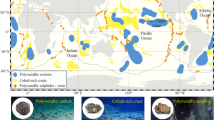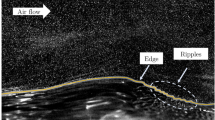Abstract
Three decades of continuous ocean exploration have led us to identify subsurface fluid related processes as a key phenomenon in marine earth science research. The number of seep areas located on the seafloor has been constantly increasing with the use of multi-scale imagery techniques. Due to recent advances in transducer technology and computer processing, multibeam echosounders are now commonly used to detect submarine gas seeps escaping from the seafloor into the water column. A growing number of en-route surveys shows that sites of gas emissions escaping from the seafloor are much more numerous than previously thought. Estimating the temporal variability of the gas flow rate and volumes escaping from the seafloor has thus become a challenge of relevant interest which could be addressed by sea-floor continuous acoustic monitoring. Here, we investigate the feasibility of estimating the volumetric flow rates of gas emissions from horizontal backscattered acoustic signals. Different models based on the acoustic backscattering theory of bubbles are presented. The forward volume backscattering strength and the inversion volumetric flow rate solutions were validated with acoustic measurements from artificial gas flow rates generated in controlled sea-water tank experiments. A sensitivity analysis was carried out to investigate the behavior of the 120-kHz forward solution with respect to model input parameters (horizontal distance between transducer and bubble stream, bubble size distribution and ascent rate). The most sensitive parameter was found to be the distance of the bubble stream which can affect the volume backscattering strength by 20 dB within the horizontal range of 0–200 m. Results were used to derive the detection probability of a bubble stream for a given volume backscattering strength threshold according to different bubble flow rates and horizontal distance.












Similar content being viewed by others
Abbreviations
- a :
-
Radius of bubble
- n(a):
-
Concentration of bubbles per classes of radii
- k :
-
Acoustic wave number
- f 0 :
-
Resonance frequency of bubble
- s v :
-
Volume backscattering coefficient (m−1)
- S v :
-
Volume backscattering strength (dB re m−1)
- σ bs :
-
Acoustic backscattering cross-section (m2)
- TS :
-
Target strength (dB re 1 m2)
- z :
-
Depth
- v ascent :
-
Ascent rate of bubbles
- F v :
-
Bubble volumetric flow
- N t :
-
Number of bubbles of radius a per time unit
- N m :
-
Number of bubbles per meter
- N i :
-
Number of bubbles in the integrated volume
- l i :
-
Integration bin width
- V i :
-
Echo-integrated sampling volume
- R :
-
Beam radius
References
Anderson VC (1950) Sound scattering from a fluid sphere. J Acoust Soc Am 22(4):426–431. http://dx.doi.org/10.1121/1.1906621
Artemov YG, Egorov VN, Polikarpov GG, Gulin SB, Kovalevsky AO (2007) Methane emission to the hydro- and atmosphere by gas bubble streams in the Dnieper paleo-delta, the Black Sea. Rep Natl Acad Sci Ukr 5:110–116
Bigalke NK, Enstad LI, Rehder G, Alendal G (2010) Terminal velocities of pure and hydrate coated CO2 droplets and CH4 bubbles rising in a simulated oceanic environment. Deep Sea Res I 57:1102–1110
Clay CS, Horne JK (1994) Acoustic models of fish: the Atlantic cod (Gadus morhua). J Acoust Soc Am 96:1661–1668. http://dx.doi.org/10.1121/1.410245
Clift R, Grace J, Weber M (1978) Bubbles, drops, and particles. Academic Press, New York
Demer DA, Renfree JS (2008) Variations in echosounder-transducer performance with water temperature. ICES J Mar Sci 65:1021–1035
Dupré S, Berger L, Le Bouffant N, Scalabrin C, Bourillet J-F (2014) Fluid emissions at the Aquitaine Shelf (Bay of Biscay, France): a biogenic origin or the expression of hydrocarbon leakage? In: Revision, continental shelf research
Fleischer P, Orsi TH, Richardson MD, Anderson AL (2001) Distribution of free gas in marine sediments: a global overview. Geo-Mar Lett 21:103–122
Foote KG, Knudsen HP, Vestnes G, MacLennan DN, Simmonds EJ (1987) Calibration of acoustic instruments for fish density estimation: a practical guide. ICES Coop Res Rep 144:81
Foucher J-P, Dupré S, Scalabrin C, Feseker T, Harmegnies F, Nouze H (2010) Changes in seabed morphology, mud temperature and free gas venting at the Hakon Mosby mud volcano, offshore northern Norway, over the time period 2003–2006. Geo Mar Lett 30(3–4):157–167. doi:10.1007/s00367-010-0193-z
Furusawa M (1988) Prolate spheroidal models for predicting general trends of fish target strength. J Acoust Soc Jpn 9:13–24
Géli L, Henry P, Zitter T, Dupré S, Tryon M, Cagatay MN, Mercier de Lépinay B, Le Pichon X, Sengör AMC, Görür N, Natalin B, Uçarkus G, Ozeren S, Volker D, Gasperini L, Bourlange S, the Marnaut Scientific Party (2008) Gas emissions and active tectonics within the submerged section of the North Anatolian Fault zone in the Sea of Marmara. Earth Planet Sci Lett 274(1–2):34–39
Greinert J (2008) Monitoring temporal variability of bubble release at seeps: the hydroacoustic swath system GasQuant. J Geophys Res 113:C07048
Greinert J, Nützel B (2004) Hydroacoustic experiments to establish a method for the determination of methane bubble fluxes at cold seeps. Geo-Mar Lett 24:75–85
Greinert J, Artemov Y, Egorov V, De Batist M, McGinnis D (2006) 1300-m-high rising bubbles from mud volcanoes at 2080 m in the Black Sea: hydroacoustic characteristics and temporal variability. Earth Planet Sci Lett 244:1–15
Hsu SK, Wang SY, Liao YC, Yang TF, Jan S (2013) Tide-modulated gas emissions and tremors off SW Taiwan. Earth Planet Sci Lett 369–370:98–107
Johnson RK (1977) Sound scattering from a fluid sphere revisited. J Acoust Soc Am 61(2): 375–377 and “Erratum: ‘Sound scattering from a fluid sphere revisited. J Acoust Soc Am 63(2):553–564
Judd AG (2004) Natural seabed gas seeps as sources of atmospheric methane. Environ Geol 46:988–996
Judd AG, Hovland M (2007) Seabed fluid flow. Cambridge University Press, New York
Lebourges-Dhaussy A, Coetzee J, Hutchings L, Roudaut G, Nieuwenhuys C (2009) Zooplankton spatial distribution along the South African coast studied by multifrequency acoustics, and its relationships with environmental parameters and anchovy distribution. ICES J Mar Sci 66:1055–1062
Leifer I (2010) Characteristics and scaling of bubble plumes from marine hydrocarbon seepage in the Coal Oil Point seep field. J Geophys Res 115:C11014. doi:10.1029/2009JC005844
Leifer I, de Leeuw G, Leo H, Cohen LH (2003) Optical measurement of bubbles: system design and application. J Atmos Ocean Technol 20:1317–1332
Lurton X (2002) An introduction to underwater acoustics. Principles and applications. Praxis Publishing Ltd, Chichester
McGinnis DF, Greinert J, Artemov Y, Beaubien SE, Wuest A (2006) Fate of rising methane bubbles in stratified waters: how much methane reaches the atmosphere? J Geophys Res 111:C09007. doi:10.1029/2005JC003183
Medwin H, Clay CS (1998) Fundamentals of acoustical oceanography. Academic Press, San Diego
Nikolovska A, Sahling H, Bohrmann G (2008) Hydroacoustic methodology for detection, localization, and quantification of gas bubbles rising from the seafloor at gas seeps from the eastern Black Sea. Geochem Geophys Geosyst 9(10):Q10010. doi:10.1029/2008GC002118
Ostrovsky I, McGinnis DF, Lapidus L, Eckert W (2008) Quantifying gas ebullition with echosounder: the role of methane transport by bubbles in a medium-sized lake. Limnol Oceanogr Methods 6:105–118
Paull CK, Ussler W, Borowski WS, Spiess FN (1995) Methane-rich plumes on the Carolina continental rise: associations with gas hydrates. Geology 23(1):89–92
Rehder G, Brewer PW, Peltzer ET, Friederich G (2002) Enhanced lifetime of methane bubble streams within the deep ocean. Geophys Res Lett 29(15):1731
Rehder G, Leifer I, Brewer PG, Friederich G, Peltzer ET (2009) Controls on methane bubble dissolution inside and outside the hydrate stability field from open ocean field experiments and numerical modelling. Mar Chem 114:19–30
Rona P-A, Palmer DR, Jones C, Chayes DA, Czarnecki M, Carey EW, Guerrero JC (1991) Acoustic imaging of hydrohermal plumes, East Pacific Rise, 21 N, 109 W. Geophys Res Lett 18:2233–2236
Ruhl HA, André M, Beranzoli L, Cagatay MN, Colaco A, Cannat M, Danobeitia JJ, Favali P, Geli L, Gillooly M, Greinert J, Hall POJ, Huber R, Karstensen J, Lampitt RS, Larkin KE, Lykousis V, Mienert J, Miranda JM, Person R, Priede IG, Puillat I, Thomsen L, Waldmann C (2011) Societal need for improved understanding of climate change, anthropogenic impacts, and geo-hazard warning drive development of ocean observatories. European Seas. Prog Oceanogr 91(1):1–33
Ryan TE, Kloser RJ, Macaulay GJ (2009) Measurement and visual verification of fish target strength using an acoustic-optical system attached to a trawlnet. ICES J Mar Sci 66(6):998–1006
Sauter EJ, Muyakshin SI, Charlou JL, Schlüter M, Boetius A, Jerosch K, Damm E, Foucher JP, Klages M (2006) Methane discharge from a deep-sea submarine mud volcano into the upper water column by gas hydrate-coated methane bubbles. Earth Planet Sci Lett 243(3–4):354–365
Schneider von Deimling J, Rehder G, Greinert J, McGinnis DF, Boetius A, Linke P (2011) Quantification of seep-related methane gas emissions at Tommeliten, North Sea. Cont Shelf Res 31:867–878
Simmonds JE, MacLennan DN (2005) Fisheries acoustics. Blackwell Publishing, Oxford
Stanton TK (1989) Simple approximate formulas for backscattering of sound by spherical and elongated objects. J Acoust Soc Am 86(4):1499–1510
Stanton TK, Sellers CJ, Jech JM (2012) Resonance classification of mixed assemblages of fish with swimbladders using a modified commercial broadbanc acoustic echosounder at 1–6 kHz. Can J Fish Aquat Sci 69:854–868
Tang D (1996) Modeling high-frequency acoustic backscattering from gas voids buried in sediments. Geo Mar Lett 16:261–265
Trenkel V, Berger L (2013) A fisheries acoustic multi-frequency indicator to inform on large scale spatial patterns of aquatic pelagic systems. Ecol Indic 30:72–79. doi:10.1016/j.ecolind.2013.02.006
Trenkel VM, Mazauric V, Berger L (2008) The new fisheries multibeam echosounder ME70: description and expected contribution to fisheries research. ICES J Mar Sci 65:645–655
Westbrook GK, Thatcher KE, Rohling EJ, Piotrowski AM, Pälike H, Osborne AH, Nisbet EG, Minshull TA, Lanoisellé M, James RH, Huhnerbach V, Green D, Fisher RE, Crocker AJ, Chabert A, Bolton C, Beszczynska-Möller A, Berndt C, Aquilina A (2009) Escape of methane gas from the seabed along the West Spitsbergen continental margin. Geophys Res Lett 36(15):L15608
Acknowledgments
The authors thank the members of Testing Pool Facilities and Technological Research Unit of Ifremer for their help during experiments in water tank. The authors thank the members of Marine Geoscience Research Unit of Ifremer who also contributed to this work. The authors thank IRD/LEMAR acoustic team for their support during some experiments. Part of this paper reports postdoctoral work of I. Leblond funded by TOTAL.
Author information
Authors and Affiliations
Corresponding author
Rights and permissions
About this article
Cite this article
Leblond, I., Scalabrin, C. & Berger, L. Acoustic monitoring of gas emissions from the seafloor. Part I: quantifying the volumetric flow of bubbles. Mar Geophys Res 35, 191–210 (2014). https://doi.org/10.1007/s11001-014-9223-y
Received:
Accepted:
Published:
Issue Date:
DOI: https://doi.org/10.1007/s11001-014-9223-y




